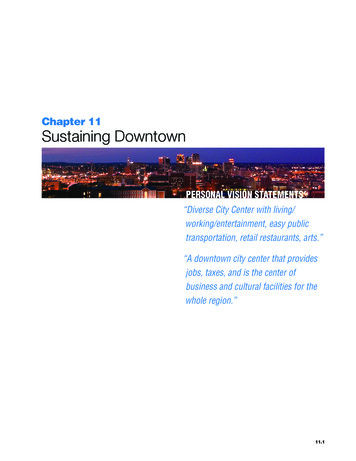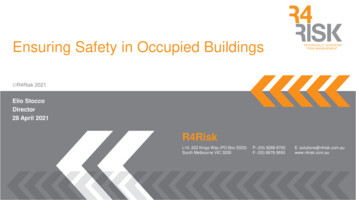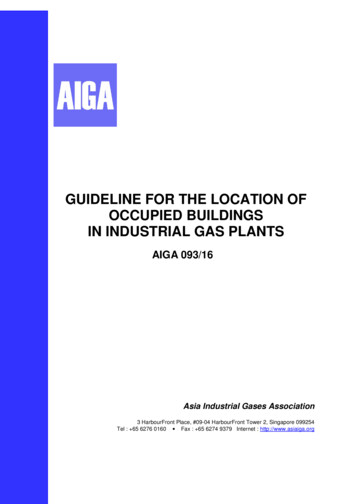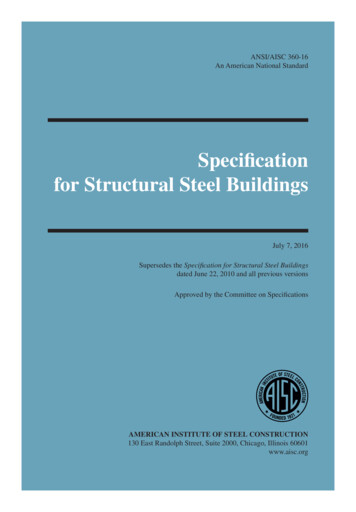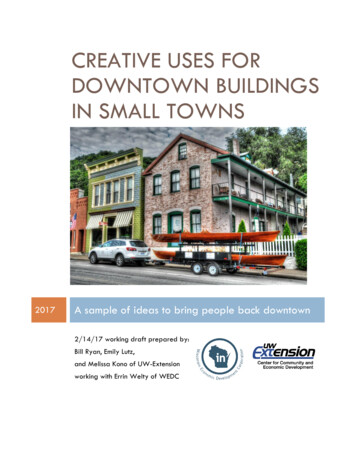
Transcription
CREATIVE USES FORDOWNTOWN BUILDINGSIN SMALL TOWNS2017A sample of ideas to bring people back downtown2/14/17 working draft prepared by:Bill Ryan, Emily Lutz,and Melissa Kono of UW-Extensionworking with Errin Welty of WEDC
Creative Uses for Downtown Buildings in Small TownsCreative Uses for DowntownBuildings in Small TownsA SA MPLE OF IDE A S TO BRING PE OPL E BACK D OWN TOWNABOUTThis report provides a sample of how downtown buildings in small towns can be put to productive use ingenerating activity and community pride. It is intended to stimulate new ideas for reusing buildings for retail,food and beverage, services, and community spaces.SITUATIONSmall town downtowns (in municipalities with less than 5,000 people) often struggle with empty storefrontsand underutilized buildings. These downtowns were once the hub of commerce and community activities. A fullrange of retail stores once occupied the main street and served as the shopping center for the community.During the 1970s, things began to change in these small towns. Regional shopping centers and large discountstores were being developed in larger communities often an hour or less away. With improvements in thetransportation system, and increased reliance on automobile travel, more and more small town consumerslooked to the bigger town down the road as the place to shop.With these consumer changes came the demise of main street retail as it once was. Clothing, shoe, variety,jewelry and other downtown anchor stores have disappeared. Today, many small town downtowns face thefollowing challenges: Highway bypasses that have changed traffic patterns.Growth in large-format retail.Remaining downtown businesses that are often limited to restaurants, taverns, salons, and gas stations.Loss of essential grocery, pharmacy, and hardware stores.Business operators that have no transition plan.Vacant real estate that is owned by absentee landlords.New competition from an online market.Changing consumers’ preferences coupled with decreasing spending power.While change continues in many rural places, there are opportunities to rejuvenate downtowns through theattraction and nurturing of creative building uses. This publication will help us explore new opportunities fordowntown. The intent is not to reinvent the past, but to stimulate ideas for the future that will contribute to theeconomic health of the community.Page 1
Creative Uses for Downtown Buildings in Small TownsCURRENT DOWNTOWN BUSINESS MIX IN SMALL TOWNSToday, small rural downtowns have unique issues that are often very different from those in largercommunities. Long gone are the one stop downtown shopping districts with products ranging from apparel tohardware. It is helpful to look at the current business mix in small town downtowns to understand whatbusinesses are currently functioning there. The following tables present the number of businesses locatedwithin a half-mile of the center of downtowns in small Wisconsin communities. All retail categories andselective service business categories for two population categories are included.Cities/Villages with 1,000-2,500 Pop.1Avg. NumberNAICS DescriptionPer CommunityFull-service restaurantsDrinking places (alcoholic bev.)Beauty salonsGasoline stationsAuto. Mech. & electrical repairGrocery storesOther amusement (bowling, golf)Gift, novelty, & souvenir storesUsed merchandise storesAuto. parts, accessories, & tire storesAuto. body, paint, interior, & glassFloristsSpecialty food storesBarber shopsHardware 0.530.520.500.47Cities/Villages with 2,500-5,000 Pop.2Avg. NumberNAICS DescriptionPer CommunityFull-service restaurantsBeauty salonsDrinking places (alcoholic bev.)Gasoline stationsOther amusement (bowling, golf)Auto. mech. & electrical repairGift, novelty, & souvenir storesUsed merchandise storesGrocery storesAuto. parts, accessories, & tire storesAppliance, tv, & other electronicsFloristsBarber shopsSporting goods storesPharmacies & drug 0.880.780.730.72Source: Retail and Service Business Mix Analysis of Wisconsin’s Downtowns. Bill Ryan, Beverly Stencel, and Jangik Jin. Universityof Wisconsin – Extension.The current business mix in small towns of Wisconsin is heavily represented by food, beverage and personalcare businesses. There are typically few comparison-shopping businesses such as apparel or home furnishings.Many are also missing important convenience businesses such as hardware stores or pharmacies. Servicebusinesses, civic uses and churches are also important anchors, but are not included in this analysis.12Average of 143 Downtowns in WisconsinAverage of 60 Downtowns in WisconsinPage 2
Creative Uses for Downtown Buildings in Small TownsEXAMPLES OF CREATIVE USESAlthough current downtown tenants provide a good base of locally owned businesses, they are often notsufficient to fill storefronts vacated by previous retail uses. The following section explores a sample ofpossible building uses that add life to the downtown, while serving local residents with goods and servicesthat’s currently offered. Most of the examples are from small towns with less than 5,000 people.Examples represent retail, food and beverage stores, services, and other community uses. For each example aone-page case study is presented that describes how it got started, who it serves, building improvementsmade, and if available, financing information.Case studies include: Grocery StoreGallery, Dining, and EntertainmentFitness CenterCommunity Gathering SpaceFood TruckPet Adoption CenterArtistic Studio and ShowroomArt SpacePerforming Arts SchoolAudio Engineering SchoolRetail IncubatorOutdoor Retail Market PlacePop-up ShopCommunity MarketplaceCoffee Shop and BistroMuseumPet Food StoreBed and BreakfastDestination Quilting BusinessTele PharmacyAntiquesFloral ShopCity GovernmentAdditional ideas:Ag. Tourism Businesses (winery, cheese, beer, etc.)Artist SpacesAutomotive RepairsCarpentry ShopConsignment StoreCo-Working Space for EntrepreneursDay CareEbay Selling CenterEducation Center (Adults)Elderly Care CenterFarmer’s Market (Inside)General StoreGift/Local Art Destination BusinessesHair SalonsLaundromatMusic Studio/LessonsPhotographerPublic LibraryRepair ServiceSchool Business IncubatorSmall-Scale ManufacturingTourism Visitor CenterUsed Car ShowroomUsed MerchandiseYouth Center (After School)More case studies are available in theUniversity of Wisconsin-ExtensionInnovative Downtown Business wnbusinesses/Page 3
Creative Uses for Downtown Buildings in Small TownsGROCERY STORE:CEDAR STREET MARKETTIGERTON, WI (POP. 728)Founder and Owner, Judi Hegewald,brings a large variety of food items toTigerton, WI, a community previouslywithout a grocer. The grocery storeoffers residents a wide selection ofproducts, while also saving themmoney.How it got started:As the owners are from nearby Birnamwood, they knew that the surrounding area needed a local andaffordable grocery store. Hegewald became aware of a suitable location in a long-vacant former Red Owlstore in Tigerton, centrally located downtown. Although the building had been stripped of most of its systemsand the ceiling was falling in, Hegewald negotiated a suitable price on the property with plans to restore itfor use as a grocery store.Who it serves:The business draws “value” customers from surrounding towns due to its national and private label brands,closeout products, surplus and overstock products, items that are short dated or slightly past the “best buy”dates, cans and boxes with minor damage, quality meats, produce, and dairy. These products provide localresidents with food products that are held to high standards.Building improvements:Although it was built as a grocery store with appropriate layout and loading areas, the building had beenlong vacant and required full renovation, including new electrical and HVAC, roof replacement and interiorand exterior improvements. Additionally, all new coolers, freezers, and deli equipment were installed tocreate a modern grocery store.Funding:Funding for the project came from personal savings and a small business loan from a local bank, as well assignificant sweat equity from Judi, husband Roger, and the couple’s six children.Website: http://www.csmtigerton.com/index.phpPage 4
Creative Uses for Downtown Buildings in Small TownsGALLERY, DINING ANDENTERTAINMENTARTSEMPORIUM/ESSENHAUSWABENO, WI (POP. 1,100)Founders and Owners, Tim &Connie Friesen, bring excellent foodand drink to rural northeastWisconsin. The business offers livemusic, art to explore, and dinnertheater shows.How it got started:The Arts Emporium/Essenhaus, established in 2014, occupies the former Eagle Saloon. The building was in aserious state of disrepair when the Friesens took over.Who it serves:The business draws customers from communities throughout northeastern Wisconsin and has become adestination for both locals and visitors.Building improvements:The ruined drop ceiling and all associated lighting and wiring had to be removed. Additionally, the originaltin ceiling was patched and new lighting was added. A second restroom was needed, as well as the frontand back bar (salvaging some of the original details). In addition, a stage and theatrical lighting wereadded. The kitchen had to be completely remodeled and all appliances replaced. The outside of thebuilding was repainted, and owners added a mural that graces the front of the building.Funding:Building renovations were done with considerable help from community members putting their expertise andsweat equity, with no outside financing.Website: http://essenhauswabeno.comPage 5
Creative Uses for Downtown Buildings in Small TownsFITNESS CENTERFIT BOXCENTRAL CITY, IA (POP. 1,257)Owner and founder of Fit Box LLC,Stacey Colledge, wanted toprovide rural communities in n LinnCounty with a clean, modernfitness facility that is appealing toboth men and women. Eventuallyshe plans to partner withindependent contractors to offerclasses and personal training.How it got started:Stacey purchased the building in the fall of 2015, with the intent of renting out the commercial space andupper story apartment. However, the local Main Street program had just completed a market analysis whichidentified a fitness center as a top need in Central City. With limited time to operate a store and managestaff, a self-serve fitness center seemed like a good fit.Who it serves:Fit Box is geared toward fitness conscious people within a 10-minute drive of Central City who do not want towaste 40 to 60 minutes driving to and from a comparable fitness center in Cedar Rapids. The equipment(which includes treadmills, ellipticals, bikes, free weights, weight machines, TRX and resistance bands, andmore) is wide ranging to appeal to the broadest customer base possible, while keeping within a smallerbudget and building footprint.Building improvements:The building had not been updated since the early 90’s when it was a lawyer’s office. Stacey hired acontractor to do substantial renovations. This included removing all the interior walls, installing a supportbeam, new electrical with motion sensors for the lighting, plumbing, HVAC, data cables for security cameras, akey card access system, expanding the bathroom, and installing new insulation and doors to cut down on thesound transfer between the upper apartment and the first floor.Funding:Stacey created the logo, website, marketing design, and construction finish work to cut costs. She alsoprivately funded the building purchase, renovations and equipment. Currently, Stacey is applying for grantfunding for renovations to the exterior of the building and new windows on both floors.Website: https://www.ccfitbox.com/Page 6
Creative Uses for Downtown Buildings in Small TownsCOMMUNITY GATHERING SPACETHIRD PLACEGOODHUE, MN (POP. 1,200)Located in a former bank building withstriking windows, the Third Place serves as acommunity gathering space thataccommodates local meetings, events, andindividual users. The owners of the buildingcreated this public space to benefit thecommunity.How it got started:The owners of the building are truly good neighbors in Goodhue. Regina Poncelet is a teacher, while herhusband operates the local convenience store. They saw an opportunity to purchase a landmark buildingdowntown. Not wanting the commitments of another business, they decided to create a community space thatwould add to the quality of life in Goodhue. Inspired by their daughter who is a student of urban planning,they create the “Third Place” in September 2015.Who it serves:The Third Place serves community groups and individual users much like a public library. The unattendedfacility can be reserved for school groups, card groups, showers, class reunions, and other organizations.Building improvements:The Third Place has been renovated as a quiet space for reading and studying, much like a library. PublicWi-Fi is available. A selection of books occupies one wall and a pay-as-you-go coffeemaker is available onan honor system. It is open from 7:30 AM to 6 PM daily. While unattended, it has security cameras.Funding:The owners purchased the bank building after it was listed on the market. They are considering renovating theupstairs as a rental income apartment.Page 7
Creative Uses for Downtown Buildings in Small TownsFOOD TRUCKHORSERADISH FOODTRUCK & ALLEY CAFEPRINCETON, WI (POP. 1,192)Founder and owner, Matt Trotter,serves creative sandwiches andsalads from an old school bus nextto his popular retail shop, Teak &Soxy, in central Wisconsin. Thebusiness - operated by himself, hismother, brother and partner - offers local ingredients with craft beer and wines for a unique street sideexperience.How it got started:The family has always enjoyed food and cooking. The winter after Teak & Soxy's third season, they got thefood truck bug. After some additional research, the owners found a dilapidated school bus, which they had tomove from Northern Wisconsin to its current location outside the store. Before long, they were applying forlicensing and conducting research on the industry. Green Lake had a community kitchen available, whichmade the risk and initial investment easier to bear for the owners.Who it serves:Horseradish Food Truck has a large following of loyal locals who dine weekly. In addition, the food truckreceives numerous spikes in business through the summer tourist months. Tourists often come from Chicago,Milwaukee and Madison.Building improvements:The body of the bus received little improvements. The main improvements were a simple striped awning,wooden bar and the "horseradish" sign. The owners invested in the cafe furnishings to resemble a casual"European-style" sidewalk cafe. In 2016, they added a lattice-walled tent to house their "beer garden",which was required by the City to serve alcohol outside and has turned out to be a favorite hangout.Funding:The owners funded the food truck privately and saved a considerable amount by using the community kitchen,versus having to outfit the truck with a full on kitchen. This way, they only needed minimal refrigeration andequipment to be able to hold and finish off the food.Website: http://Facebook.com/horseradishalleycafePage 8
Creative Uses for Downtown Buildings in Small TownsPET VIEWING WINDOWPET ADOPTION NONPROFITNEILLSVILLE, WI (POP. 2,400)A pet adoption marketing concept hasbeen proposed for the empty storefrontof the H&W Building in this centralWisconsin Community.How it got started:This concept has been recommended tohelp fill a beautiful and prominentstorefront on the corner of Main Street at a busy intersection. It features adoptable pets of the Clark CountyHumane Society, a valued organization that has a lot of public support. Adoptable pets would be featured inthe windows of the storefront on Thursdays and Saturdays when there are other activities in the downtownarea, such as the Farmers Market. Volunteers of the Clark County Humane Society would transport adoptableshelter pets downtown to be featured in the storefront for a few hours to help draw visitors, while alsoincreasing the exposure these pets receive to potential families.Who it serves:This project helps the community, downtown area, and the local non-profit Humane Society. It encouragespeople to walk downtown, facilitates conversation, and connects them to the community.Building improvements:The building has been vacant for three years, but its most recent use was a community thrift store and foodpantry. Since the front display window areas are the only spaces being utilized, there are few improvementsnecessary at this time. Improvements would include housekeeping and touch up paint. Volunteers would help tokeep the area neat before, during, and after the visits.Funding:The only funding for the proposed project would be paint, and proper containment for the pets while they arevisiting the storefront during the featured times.Page 9
Creative Uses for Downtown Buildings in Small TownsARTISTIC STUDIO ANDSHOWROOMRED IRON STUDIO AND JONMICHAEL ROUTE STUDIOFREDERIC, WI (POP. 1,110)Father and son, Jack and Michael Route, workindependently side by side bringing artisticand custom metalwork to rural northwestWisconsin. Their buildings together house twometal studios and a showroom.How it got started:In 2008, the empty buildings were owned by the Village of Frederic and were slated for demolition. Michaelwrote a proposal to acquire the property for very little, which was eventually approved. Jon Michael RouteStudio moved into the space in 2012 and recently developed the showroom in the front of the building.Who it serves:Their businesses have done work nationwide through commissions and craft fairs. They haverecently added the showroom so that it become a stop for tourists and locals who may purchase theirmetalwork.Building improvements:The buildings were essentially gutted and ready for demolition. The roof leaked, along with the back wallthat was rotted. A new roof was added along with a 10-foot addition to the back and a separate studiospace. They replaced large service doors with windows, and have greatly improved the landscaping. Thefront showroom got new windows and a door, along with a stucco façade. The owners still have many moreplans to keep improving their property.Funding:In addition to sweat equity and the owners’ investment, some funding for the buildings have come from theRegional Business Fund – Façade Loan. This program helped improve the exterior of the chaelroute.comPage 10
Creative Uses for Downtown Buildings in Small TownsARTS SPACE314: RIPON COLLEGE PROJECT SPACERIPON, WI (POP. 7,733)314: Ripon College Project Space is a multi-use communityvenue for art exhibits, concerts, poetry readings, lectures,performances, speakers, classes, community events, andmore.How it got started:Zach Messitte, the president of Ripon College, conceived ofthis space as a way for the college to develop a greaterpresence in downtown Ripon and with the community. Hereached out to the three faculty advisors, who found thespace, contacted student leadership, and oversaw thespace’s opening.Who it serves:College and community members alike are invited to submittheir ideas for using this dynamic new space. Uponapproval, use of the space is completely free.Building improvements:The space is located on the main street in a reclaimed building beautifully restored by downtown managerand owner Craig Tebon after a devastating fire in December of 2013. The fire destroyed one building,severely damaged two others, and displaced many residents.Funding:314 is made possible in large part by a grant from the Kemper Foundation.Website: ace/Page 11
Creative Uses for Downtown Buildings in Small TownsPERFORMING ARTSSCHOOLTHE RUMPUSROOMMAZOMANIE, WI (POP.1,652)Founders Marcia Miquelonand Jacob Mills teachcircus arts, stage performances and create an engaging community for kids.How it got started:Owner Marcia had a desire to teach performance arts for artistic and personal reasons. She found a vacantbuilding with low rent and a high ceiling. Her first location was only part time to break even on the expenses.In 2008, Marcia became self-employed and in 2013 bought the building, which is now called the RumpusRoom. The first summer after opening, she partnered with Jacob Mills to start circus camps.Who it serves:The Rumpus Room draws heavily from the Madison area. Approximately 20 percent of attendees are localresidents. They serve a large age demographic spectrum, offering camps to children and classes to adults. Inaddition, they hold 2 - 3 long weekend workshops throughout the Upper Midwest region and host a festival inJanuary every year.Building improvements:The vacant building required new paint. Furthermore, the owners needed to put in a dance floor specificallyfor the dance workshops. Lastly, they updated the wiring in the building.Funding:The project so far was entirely self-funded. The Rumpus Room is in a Tax Increment Financing (TIF) district andthe owners have potential to gain access to some funds for a larger renovation, which they have planned forin the future. This future project would include exterior building improvements.Website: http://therumpusroom.orgPage 12
Creative Uses for Downtown Buildings in Small TownsAUDIO ENGINEERING SCHOOLSOUND HAVEN LEARNING CENTERLAKE MILLS, WI (POP. 5,708)Michael & Laurie Allison founded Sound Haven LearningCenter with the intent to bring an audio school to Lake Mills,Wisconsin. This learning center offers locals lessons in audioengineering.How it got started:Michael travelled throughout his career in the music industryand eventually settled in Wisconsin. There was a vacantchurch in Lake Mills that continuously went up for auction. Hedecided that this 11,248 sq. ft. building would be a greatspace for an audio school.Who it serves:The Sound Haven Audio School serves the local community in Lake Mills. They offer classes that range frombasic to advanced programs and are designed to aid in a student’s development as a top trained audioengineer.Sound Haven offers consultation services and space to neighboring churches, schools, and businesses to ensurethe volunteers and staff understand the basic components of audio engineering and how to operate with bothbasic and more complex systems.In addition to audio classes, Laurie runs Sound Haven’s events such as weddings, receptions, showers andparties.Building improvements:Numerous renovations were needed before the church could function as a studio. The building received athorough cleaning, new carpeting, new electrical, paint, plumbing and heating. Most importantly, the churchneeded new boilers, which was a significant expense.Funding:The renovation of the church was entirely funded by Michael and Laurie Allison.Website: http://www.soundhavenlearningcenter.com/Page 13
Creative Uses for Downtown Buildings in Small TownsRETAIL INCUBATORTHE VILLAGEWASHINGTON, IA (POP. 7,200)Owner and founder, Cathy Lloyd,created The Village with the intent tobring life back to downtown by givingstartup entrepreneurs a chance to testout their business model on a smallerscale.How it got started:An old department store building withover 15,000 square feet sat empty for years. Cathy Lloyd saw the opportunity to partner with the buildingowner who was renovating the second floor.Who it serves:Customers include residents and tourists who drive for the experience of shopping in the unique setting. TheVillage generates new business activity among residents, giving potential business owners a chance toexperiment and learn at a small scale before growing larger.Building improvements:The first floor was converted to a retail complex consisting of small boutique-type shops surrounding a centralcourtyard. The shops are designed with wood façade fronts to resemble a turn-of-the century Iowa village.Each shop features traditional clapboard siding, awnings, window boxes, and every front is unique.Additional smaller vendors occupy tables and push carts in the central courtyard. A wall is lined withbookshelves, operating as a mini-bookstore. Another wall is used to display local art for sale.Funding:Lloyd rented the main area from the building’s owner, divided it at her own expense, and collects rent fromthe individual merchants.Website: http://www.thevillagewashingtoniowa.com/Read more about it: uilding-many-new-retail-stores.htmlPage 14
Creative Uses for Downtown Buildings in Small TownsOUTDOOR RETAILMARKETPLACETIONESTA MARKETVILLAGETIONESTA, PA (POP. 500)The Tionesta Market Village wasonce a group of buildings thatwere destroyed by adevastating fire.How it got started:A local effort began in early 2012 to rebuild the marketplace. They drew inspiration from seasonal kiosks inthe mall and created temporary use retail spaces with garden sheds. The goal was to provide a uniqueshopping experience and entertainment for residents and visitors. The community, businesses, and locals haveall been supportive and made this venture possible.Who it serves:Their website says it well: This "mini Main Street" gives residents and visitors a place to shop and relax, andgives small retail businesses the opportunity to get started selling their products in a high-visibility and hightraffic location. It’s an opportunity for the local person who makes fishing lures to sell his product as well asthe winery that is located out in the country to sell wine in town. Visitors and locals alike shop here and it’s anadded boon to the community.Building improvements:A local Amish company, Cypress Clock and Gift Shop, built the sheds and they sit on what was an empty lot.The buildings are 1800’s in design.Funding:The total cost including site preparation and sheds was less than 40,000 and was provided by the industrialdevelopment authority. Today the project generates revenue through building rental, and there is a waitinglist for perspective vendors.Website: http://marketvillage.forestcounty.com/Read more about it: -development-idea-tiny-businessvillages.htmlPage 15
Creative Uses for Downtown Buildings in Small TownsPOP-UP SHOPVIROQUA CHAMBER MAIN STREETHOLIDAY POP-UP PROGRAMVIROQUA, WI (POP. 4,362)The Viroqua Chamber Main Street Pop Up Shop initiativewas a response to increasing vacancies in an otherwiseactive downtown. The program allowed people in thecommunity with innovative ideas to occupy vacantstorefronts free of charge for a three-month period.How it got started:The Viroqua Chamber Main Street applied a model usedthroughout the country that focuses on education ofentrepreneurs, their mentoring, and financial assistance. Theprogram was designed as a creative answer to fillvacancies for holiday shopping.Who it serves:The community supports new businesses by offeringassistance during the start-up phase and then buying from these local retailers. This initiative has a long-termimpact on the community by keeping the downtown vibrant and alive, while also creating a strong retail andservice industry. A pop-up shop is open for a short period of time, to test the format and see if the business issomething that the community will support.Building improvements:In most cases, the Chamber used buildings that needed some updating and change. Having foot traffic invacant buildings is excellent for selling real estate or negotiating future leases, so the arrangement benefitedall parties.Funding:The Viroqua Chamber Main Street invested staff time and 1,500 initially. In 2016, the chamber received agrant from Vernon County to assist with rent cost in the amount of 2,500. Nearly every property owner orlandlord invested in the program by discounting rent and working with the Chamber.Website: www.viroqua-wisconsin.comPage 16
Creative Uses for Downtown Buildings in Small TownsMARKETPLACE, LOCALARTISTS, AND RETAILTHE HISTORIC VIROQUAPUBLIC MARKETVIROQUA, WI (POP. 4,362)The Historic Viroqua Market opened in2004 with the intention of providinglocals an opportunity to sell theirgoods. Today, the market offersunique retail space and generates business.How it got started:The old Peterson Motors building came up for sale and owner Tony Macasat saw the potential to invest andturn it into something the community could use. The Macasat family ended up purchasing the building shortlyafter. Originally, the market started out by holding festivals because they did not have enough vendors whenit initially opened. It evolved over time to host permanent vendors and their booths.Who it serves:Viroqua Public Market started by serving local residents. Over the past 12 years, the word has spread andthe market now serves a three state area. The markets serve customers interested in lifestyle retail includingVIVA Art Gallery, and Rooted Spoon Kitchen Table, Once Read Books (a tiny bookstore) and Essence ofClarity (a new age healing center).Building improvements:The old building was covered in soot from years of being a mechanic repair shop. The owners had to spend agreat deal of time cleaning the floors and rafters before adding a structure inside the large building.The old auto garage was very large, so the owners created three separate storefronts. They added wallsinside the building to create different sections and also added four mini suites. The mini suites act as stores,which have held numerous types of businesses.The street lamps, large fountain, and occasional tree add to the ambiance and give the impression of beingoutside, at a quaint European street market; with details down to hand-painted brick walls and a real pairring-neck doves.Funding:The project was self-funded by the Macasat fam
CREATIVE USES FOR DOWNTOWN BUILDINGS IN SMALL TOWNS 2017 A sample of ideas to bring people back downtown 2/14/17 working draft prepared by
